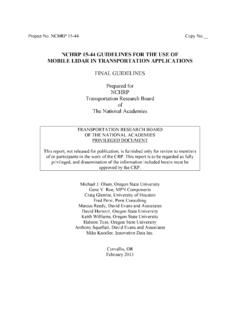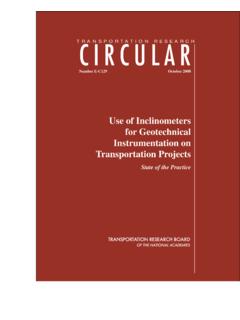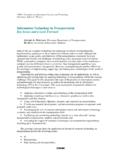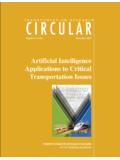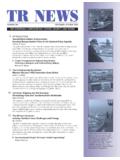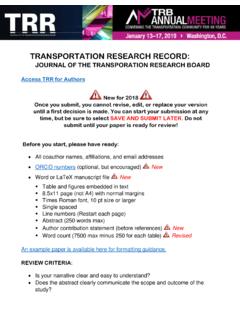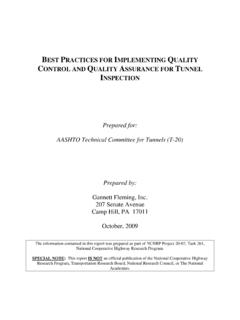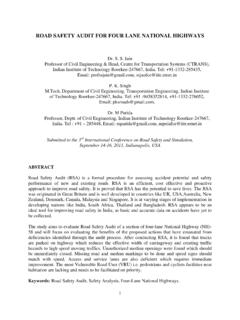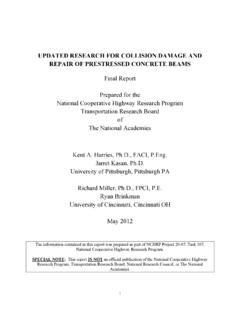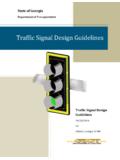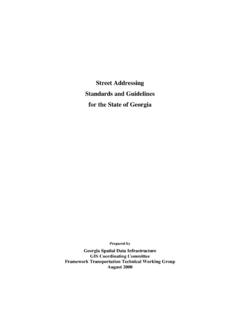Transcription of Guidelines for Dowel Alignment in Concrete …
1 Project No. 10-69 Guidelines for Dowel Alignment in Concrete Pavements APPENDIX A REVIEW OF LITERATURE AND OTHER RELEVANT INFORMATION Prepared for NATIONAL COOPERATIVE HIGHWAY RESEARCH PROGRAM (NCHRP) Transportation Research Board of The National Academies Kyle Hoegh, Research Assistant Lev Khazanovich, , Associate Professor University of Minnesota Minneapolis, MN February 2009 A-2 APPENDIX A. REVIEW OF LITERATURE AND OTHER RELEVANT INFORMATION This Appendix contains information related to: Dowel placement in Concrete pavements to identify o problems with Alignment , o extent of misalignment, o methods for determining misalignment, and o effect of misalignment on performance; Factors contributing to Dowel bar misalignment; Available approaches for estimating the effects of misalignment on pavement performance. PROBLEMS WITH Dowel PLACEMENT Dowel bars are typically placed at the mid-depth of the slab and should be parallel to the pavement surface and parallel to the direction of travel.
2 The center of the Dowel bar should be below the joint. If Dowel placement deviates from the desired position, it is said to be misaligned. Tayabji (1986) identified the following categories of Dowel misalignment (see figure ): horizontal translation; longitudinal translation; vertical translation; horizontal skew; and vertical tilt. Misalignment may result from misplacement (initially placing the dowels in an incorrect position), displacement (movement during the paving operation), or both. Dowel bars are typically placed in the joints using either basket assemblies or an automated Dowel bar inserter (DBI). A-3 HorizontaltranslationPlanHorizontalskewP lanLongitudinaltranslationPlanVerticaltr anslationSectionVerticaltiltSectionHoriz ontaltranslationPlanHorizontalskewPlanLo ngitudinaltranslationPlanHorizontaltrans lationPlanHorizontaltranslationPlanHoriz ontalskewPlanHorizontalskewPlanLongitudi naltranslationPlanLongitudinaltranslatio nPlanVerticaltranslationSectionVerticalt iltSectionVerticaltranslationSectionVert icaltranslationSectionVerticaltiltSectio nVerticaltiltSection Figure Types of Dowel misalignment (Tayabji, 1986).
3 Dowel bar tolerances vary with respect to horizontal, longitudinal, and vertical translation, horizontal skew, vertical tilt, and embedment length. Different states have adopted differing standards with respect to Dowel bar Alignment and positioning tolerances. These tolerances can be expressed as absolute maximum measures or as percentages of the length of the Dowel or thickness of the Concrete . Many states have adopted the Federal Highway Administration (FHWA)-recommended limits for horizontal and vertical Alignment (rotation) of in over 12 in ( over 305mm) or 2% (FHWA 1990). The American Concrete pavement Association (ACPA) recommends limits of 3/8 in over 12 in ( over 305mm) or 3% based on National Cooperative Highway Research Program (NCHRP) Synthesis 56 and an FHWA memo from 1989. FHWA recommended further studies to determine the validity of their 2% tolerance. Table shows the variation of Dowel bar misalignment tolerances for several states. The maximum rotation column is an absolute maximum for the horizontal skew and vertical tilt.
4 The data for the Midwest states were gathered from the 2004 state representatives reports (MCC, 2004). The data from Georgia, North Carolina, and South Carolina were gathered by e-mail from each state representative. The information from the Munich Technical University paper was obtained from an agency s research paper (Lechner, 2005). A-4 Table Variation in Dowel misalignment tolerances from state to state. Maximum Vertical Longitudinal LocationRotation (in.)Translation (in.)Translation (in.)DBIS ourceIllinois3/16 NANAnot allowedIllinois DOT Rep., Spring 2004 Indiana3/8 NANAnot allowedIndiana DOT Rep., Spring 2004 Iowa1/4 NANAnot allowedIowa DOT Rep., Spring 2004 Kansas3/81/10 of pavement DepthNAallowedKansas DOT Rep., Spring 2004 MichiganallowedStaton, Michigan DOT, Spring 2004 Basket1/81/2 NADBI1/4NA2 Minnesota1/4 NANA allowedMinnesota DOT Rep., Spring 2004 MissouriNo allowedMissouri DOT Rep., Spring 2004 Nebraska1/4 NANA allowedNebraska DOR Rep.
5 , Spring 2004 OhioNo DOT Rep., Spring 2004 Georgia9/16 NANA-Fowler et al., May , Georgia DOT 2005 North Carolina3/8 NANA-Pace, NC DOT 2005 South Carolina9/163/43-Johnson, SC DOT 2005 German Agency3/4NA2-FGSV, 2001 One limitation of existing specifications and Guidelines on Dowel placement tolerances is that they all focus on individual Dowel bars and do not fully consider the effects on pavement behavior. Different types of misalignments have different effects on pavement performance. The translational misalignments (misplacements), including longitudinal translation (which determines the Dowel embedment length), affect the effectiveness of individual Dowel bars ( , load transfer capacity). As such, the individual-bar evaluation is appropriate for misplacement errors. However, even in this case, the location of the Dowel bars may be considered. For example, the Dowel bars in the wheelpath are more critical, whereas the load transfer capacity is not critical for the bars outside of the wheelpath.
6 The rotational misalignments (horizontal and vertical misalignments) govern joint movements, and a joint-by-joint evaluation may be warranted. Dowel bars are expected to resist differential vertical movement between the slabs while allowing expansion and contraction in the horizontal direction due to thermal contraction and expansion of the Concrete . Highway agencies specify Dowel Alignment tolerances to prevent joint malfunctions due to misalignment. Commonly believed mechanisms for these malfunctions include the following: If the dowels are not placed accurately in the wheel paths ( , there is horizontal translation), it reduces their effectiveness and their ability to provide adequate joint load transfer efficiency (LTE). If the Dowel does not have sufficient embedment length on the both sides of the joint due to longitudinal translation, Concrete bearing stresses will be increased, which may cause the development of Dowel looseness and result in premature loss of LTE.
7 Horizontal skew and vertical tilt may restrain joint movements due to thermal contraction and expansion of the Concrete . This restraint increases slab tensile stresses and may increase their cracking potential. This restraint may also induce significant additional localized stresses around the dowels, which can A-5lead to spalling and/or Dowel looseness, with an accompanying decrease in the joint LTE. It is also hypothesized that Dowel rotation can increase resistnce to joint opening causing joint lockup and transverse cracking. Vertical translations of the Dowel may result in insufficient Concrete cover, which can lead to joint spalling and loss of LTE. The potential impacts of various types of Dowel misalignment on pavement performance, as identified by Tayabji (1986), are summarized in table It should be noted that, although loss of LTE is not a distress per se, poor LTE is a contributing factor in other distresses, such as premature joint faulting (Khazanovich and Gotlif, 2003).
8 Table Effect of each type of misalignment (Tayabji, 1986). Although many transportation agencies specify Alignment tolerances, relatively few laboratory and field studies have been conducted to evaluate the effects of various types and levels of misalignment on Concrete pavement performance. Several studies have evaluated the effects of Dowel misalignment on restricting joint movement due to thermal contraction and expansion of the Concrete . One such study was conducted by Segner and Cobb at the University of Alabama (1967). This study used Dowel pull-out test results to show that vertical tilt was more critical to pavement performance than horizontal skew. The study showed that a horizontal skew of mm did not increase the pullout force required. However, a vertical tilt of mm was sufficient to significantly increase the pullout force required to achieve the same joint opening. Significant spalling failures were observed with vertical tilt of mm and with horizontal skew measures of 76 mm (Leong, 2006).
9 Another study, using data from slab pullout tests with 2 oppositely misaligned dowels, found that horizontal skew and vertical tilt of less then 1 in. per 18-in. bar allowed horizontal movements up to values that would not be exceeded in the field, and pullout loads were relatively low for these Dowel misalignment levels. Table shows the force required to create a joint opening of in. for various levels of misalignment after different Concrete cure times (Tayabji, 1986). A-6 Table Maximum Pullout loads for Tayabji s slab pullout tests (Tayabji, 1986). More recently, laboratory experiments at Michigan State University were completed using slab pull-out tests with up to 5 dowels per joint (Prabhu et al., 2006). This study found that, while Dowel misalignment has only a small influence on initial debonding shear stresses, it has a significant influence on post-slip horizontal displacements. Structural distresses such as Concrete spalling and cracking increased in severity with the number of misaligned Dowel bars at the joint.
10 The misalignments measured in this study were all rotational ( , horizontal skew, vertical tilt, or a combination of both). The distresses caused by the different tests, types of misalignment, and magnitudes of misalignment are shown in tables and It should be noted that the distresses reported in these tables occurred only after unrealistically high joint openings. A-7 Table Two- Dowel slab pullout data (Prabhu et al., 2006). A-8 Table Three- and five- Dowel slab pullout data (Prabhu et al., 2006). While Dowel misalignment in the form of tilt and skew are the most common misalignments tested using laboratory techniques, a Minnesota Department of Transportation (Mn/DOT) sponsored study evaluated the effect of vertical translation. The study used Minne-ALF (an accelerated loading system) to test the effect of vertical Dowel translation ( , reduced Concrete cover) on long-term LTE. While the study was conducted using retrofitted dowels, the variables being evaluated ( , shallow Dowel placement and lack of Concrete cover) are consistent with the problems that can arise from vertical translation in new pavement construction.
